How To Start & Grow Marigold Seeds Into Beautiful Flowers
Marigold flowers are easy to grow from seeds. You can plant the soaked seeds in rich organic loose soil. Add fertilizers at the time of planting only in case the soil is deficient.
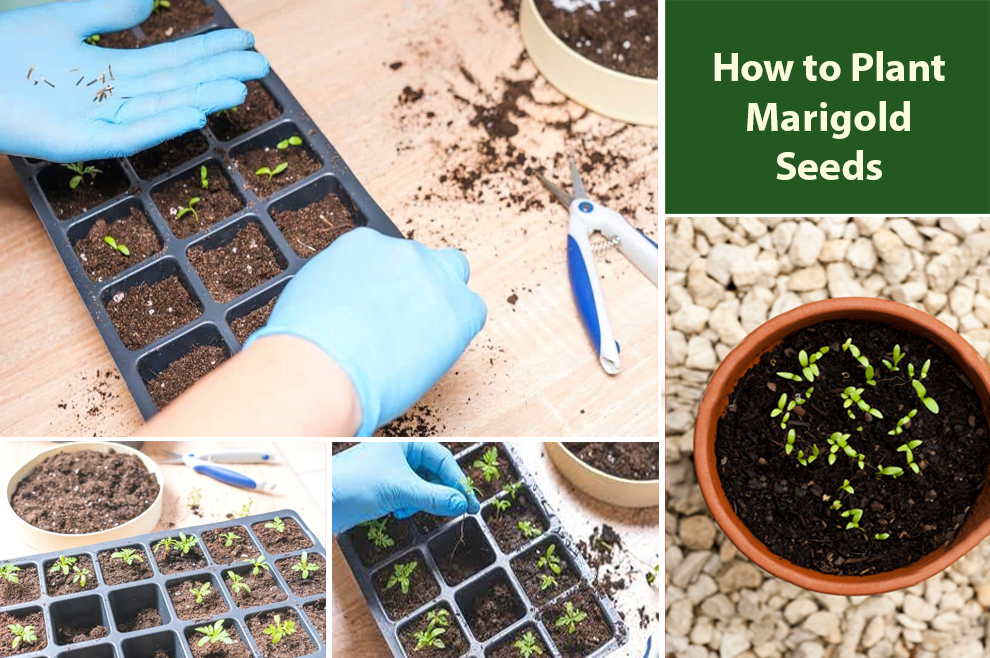
Marigolds are annual flowers that are easy to grow and maintain. They are extremely popular for their cheerful and bright blooms.
Homeowners and gardeners love it globally. To enjoy its grandeur you must know how to plant marigold seeds correctly at the right time and at the right location.
Typically, marigold seeds seek plenty of sunlight, well-drained soil, and consistent moisture to grow and germinate. The ideal soil for marigolds is one rich in organic matter with a pH between 6.0 and 7.0.
Further, marigolds thrive in warm temperatures and grow best in USDA hardiness zones two through eleven. Once you meet all the prerequisites, you must learn how to start marigold seeds.
| To plant marigold seeds, begin by working the soil. Loosen the soil to a depth of 6 to 8 inches. Mix in compost or any other organic matter.
Further, sow the seeds directly into the soil. Cover the seeds with a thin soil layer and water them thoroughly. Usually, marigolds take five to seven days to germinate and must be moist across the growing season.
Further, thin the seedlings once they grow to two-three inches, leaving 8-10 inches between smaller varieties and 12 inches distance for larger ones. |
Are you looking for a detailed guide on growing marigolds from seeds? Read below as we discuss every aspect of sowing marigold seeds in full detail.
Procuring The Marigold Seeds
When procuring the seeds, always shop from a reputable supplier to ensure they are of good quality and not infected by any diseases. Look for seeds labeled as untreated and non-GMO, if possible.
Sometimes you may not get the desired results despite following all the ‘how to grow marigold seeds’ steps to the T. It may so happen if the seed quality is poor. Thus, when shopping for the seeds, consider the following:
1. Variety: There are several different marigoldtypes, such as African, French, signet varieties, etc. Each of these varieties has diverse growth habits and characteristics. So, before procurement, consider which type of marigold would suit your garden soil, zone, or landscape.
2. Color: You can find marigolds in colors like shades of yellow, orange, red, and bi-colors. Think and analyze which colors best complement your existing plantings or add visual interest to your garden.
3. Growth habits: While some marigolds grow upright and tall, others are bushier and more compact. So, always consider the mature plant’s size and growth habits to ensure that what you buy will fit into your landscape or garden.
A) How To Plant Marigold Seeds Outdoors?
Planting the marigold seeds is a straightforward process. You can do it in a few simple steps. Let us dive into the details below:
Deciding & Prepping The Planting Site
Before you start sowing the marigold seeds outdoors, pick a suitable planting and prep the soil well. Here are the steps to follow:
1. Select a sunny spot: Marigolds do best in full sun. So pick a location receiving at least six to eight hours of direct sun daily.
2. Prepare the soil
Marigolds cherish a well-draining soil rich in organic matter. Using a garden tiller or fork, loosen the soil to a depth of at least six inches. Remove all the weeds, rocks, and grass in the area.
3. Check the soil temperature: Marigolds germinate best when the soil temperature is between 70-75°F (21-24°C). Thus, if the soil is too cold, wait until the soil warms up to the apt temperature before planting.
4. Fertilization: Typically, marigolds do not need a lot of plant food. But if the soil is poor, consider adding a balanced fertilizer for marigolds with equal parts nitrogen, phosphorus, and potassium. Mix the fertilizer into the soil before planting.
You can provide a suitable environment for marigold seeds to thrive by selecting a sunny spot with proper temperature and well-draining soil free of weeds, rocks, and grass.
Can I Plant The Seeds In Pots Or Only In The Ground?
Fortunately, you can plant marigolds in pots and on the ground. Botanists suggest that planting marigold seeds into the containers is an excellent savior if you wish to add color to your balcony or patio or have limited space.
When selecting the container, ensure it is about six to eight inches deep and wide enough to accommodate the mature plant.
Add well-draining soil into the pot, leaving approximately an inch of space on the top. Now you can sow the seeds about 1/8 inch deep in the soil, spacing them about 6 inches apart.
Should I soak marigold seeds before planting?
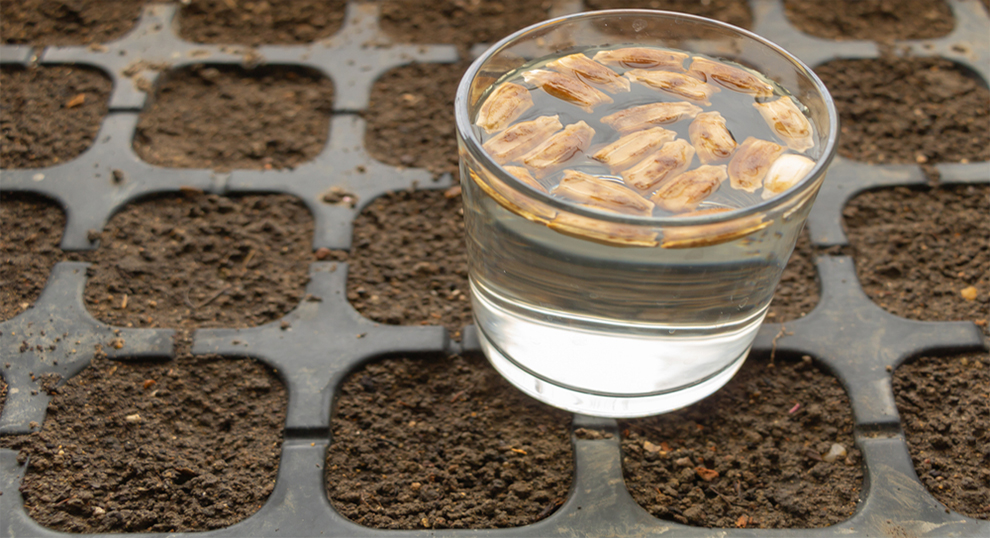
It is not necessary to soak the marigold seeds before planting, but it can accelerate the germination process. Marigold seeds have a hard outer layer, which may curtail water absorption and slow germination.
By soaking seeds in water, you soften the outer layer, accelerating the germination.
For soaking the marigold seeds:
- Place them in a cup or small bowl filled with warm water for about 4-6 hours.
- After soaking, plant the seeds in seeds in well-draining soil as directed.
- Be sure to keep the soil moist throughout the growing season.
Can you just scatter marigold seeds?
Yes, you can scatter the marigold seeds in the designated planting area. It is known as broadcasting and is a prevalent method of sowing the seeds for some kinds of plants, including marigolds.
To scatter the seeds:
- Pick a well-draining soil area that receives ample sunlight.
- Loosen the soil with a hoe or rake, removing large rocks or debris.
- Sprinkle the marigold seeds evenly over the area, not planting them too close together.
- Once you scatter seeds, rake the soil to ensure sufficient seed-to-soil contact, and then water the area to keep the soil moist.
Even though scattering marigolds is an easy and simple way to plant them, please note it may result in uneven germination or spacing.
Further, broadcasting might lead to competition between seedlings for resources, negatively impacting their growth. Thus, thinning is vital after the seedlings emerge to ensure healthy growth and proper spacing.
Which end of the marigold seed goes down?
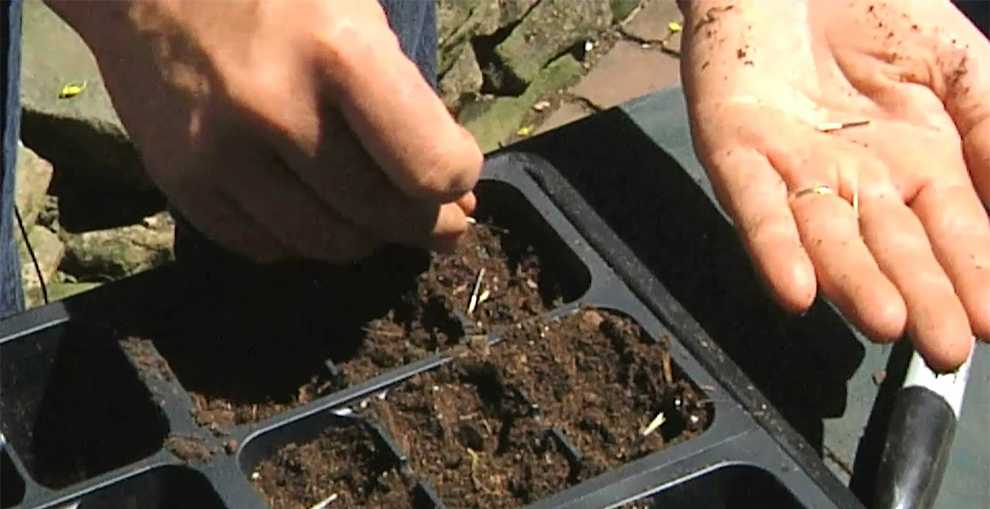
It is essential to know how to sow marigold seeds for fruitful results. Hence, always plant the seeds ensuring the pointed end faces downwards.
The sharp end is the part of the seeds from where the roots and seeds will emerge.
Growing the marigold seeds with the sharp edge facing downwards ensures the seedlings will emerge from the soil properly to develop into healthy plants.
How deep to plant marigold seeds?
You must plant the marigolds about 1/8 inch deep in well-draining soil. Planting the seeds too deep can curtail the germination, whereas if you sow them too shallow, you leave them susceptible to drying out or being eaten by insects or birds.
Hence, to plant the marigold seeds at the correct depth, use a small tool or your finger and create a shallow hole in the soil.
Place the seeds in the hold, and cover it with a thin soil layer by gently pressing down the soil to ensure apt soil-to-seed contact. Water immediately to keep it moist.
How many marigold seeds per pot?
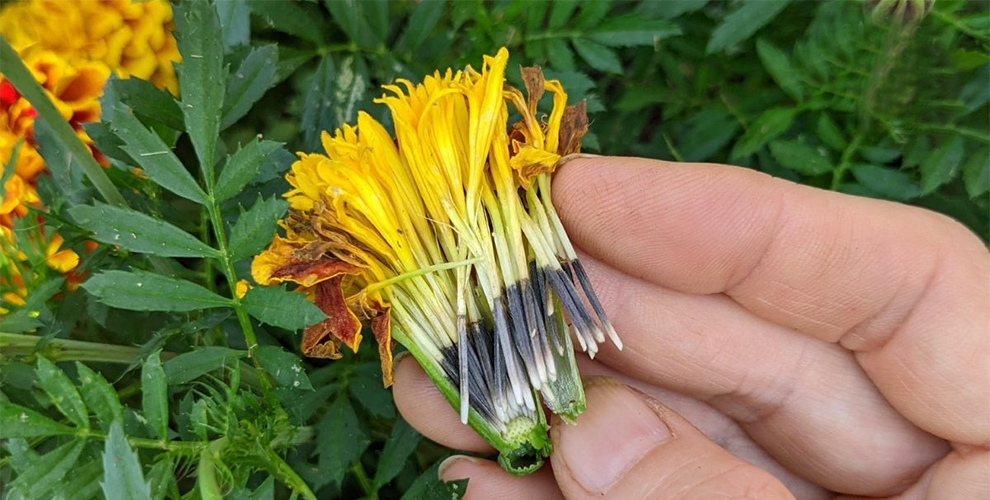
The number of marigold seeds you should plant per pot depends on the pot size. Ideally, plant only one or two seeds per pot for small containers with a diameter of 4 inches (10 cm) or less.
For larger pots, you can plant more seeds. As a general guideline, you can grow one seed for every 2-3 inches (5-7.5 cm) of pot diameter.
Is spacing a concern when planting the seeds in the ground?
Spacing is definitely a concern when planting the marigold seeds in the ground. You must plant the seeds at an apt distance apart to ensure they have ample space to grow and develop a healthy root system.
The spacing requirements vary depending on the specific marigold variety. Typically, French Marigolds must be about 8-10 inches apart, whereas African marigolds (larger varieties) must be about 10-12 inches (25-30 cm) apart.
Proper spacing is necessary to avoid overcrowding, ensure healthy growth, and prevent disease and pest issues.
How often to water marigold seeds?
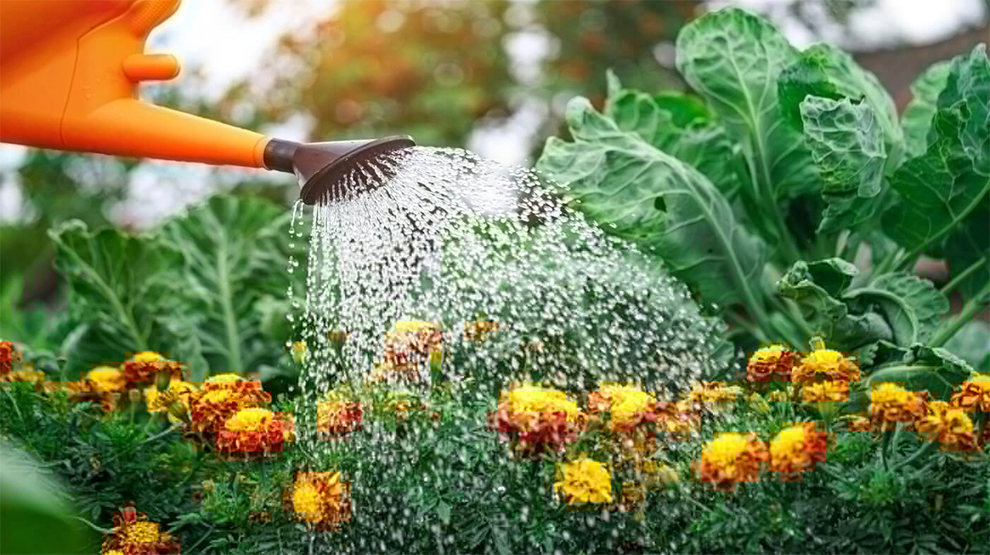
It is vital to be well-acquainted with your plant’s watering needs to learn how to grow marigold seeds.
As a general guideline, you must water the seeds immediately after planting and keep the soil moist consistently. So, water when the top soil inch (2.5 cm) feels dry.
Depending on the humidity and temperature outside, it may imply watering once or twice daily.
After the seeds germinate and the seedlings grow, you can reduce the watering frequency to once every two to three days.
As the plants grow and develop a solid root system, they become more tolerant to long periods of dry soil, but please keep monitoring the water and moisture levels as needed.
What month do you plant marigold seeds outdoors?
The best time to plant marigolds outdoors depends on the growing zone and the climate in your region.
Generally, marigolds are warm-season annuals that love to be grown in spring in early summer or following the last frost date.
For instance, in USDA hardiness zones one through seven, you can sow the marigold seeds directly into the ground in late May or early June, whereas in zones eight through eleven, you can plant them as early as March or April.
It is always a good idea to consult a gardening guide or your local extension office to know the best time for your area.
How To Germinate Marigold Seeds Quickly?
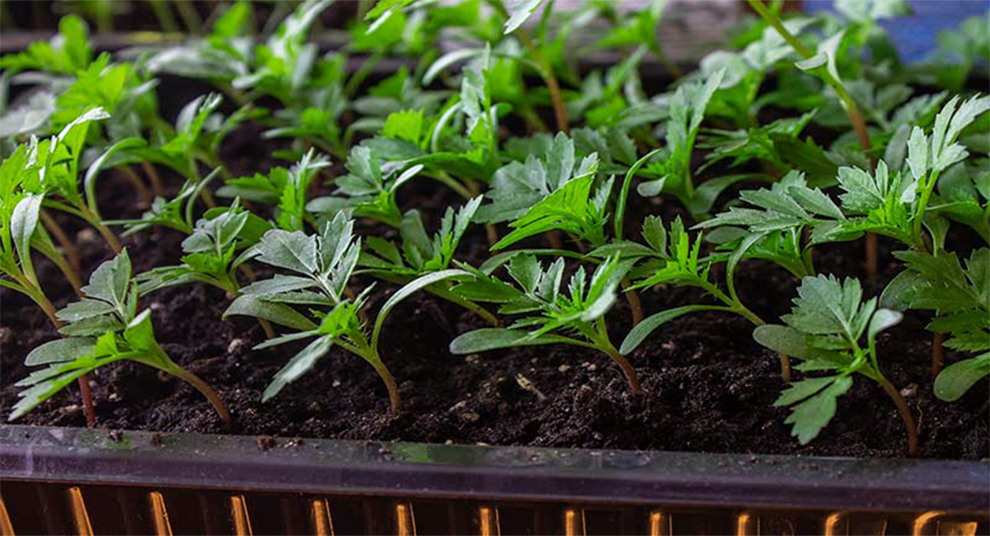
Generally, the marigold seeds germinate in five to seven days under ideal conditions. However, you can do a couple of things to speed up the germination:
- Soak the seeds in water overnight to soften the outer shell and accelerate the process.
- Provide warmth: Marigolds germinate best in warm soil. So place them on a heat mat or a warm location.
- Use a seed-starting mix to improve the germination rate and prevent damping off, a fungal disease that kills the seedlings.
- Keep the soil moist,not waterlogged, during germination. So mist using a spray bottle to dampen the surface without disturbing the seeds.
- Cover the seeds with a thin layer of seed-starting mix or vermiculite to retain moisture and improve germination.
| DID YOU KNOW? – Calendulas are not true marigolds.
Even though both belong to the Asteraceae family, they are different species and have some differences in their appearance and growing habits. |
B) How To Plant Marigold Seeds Indoors?
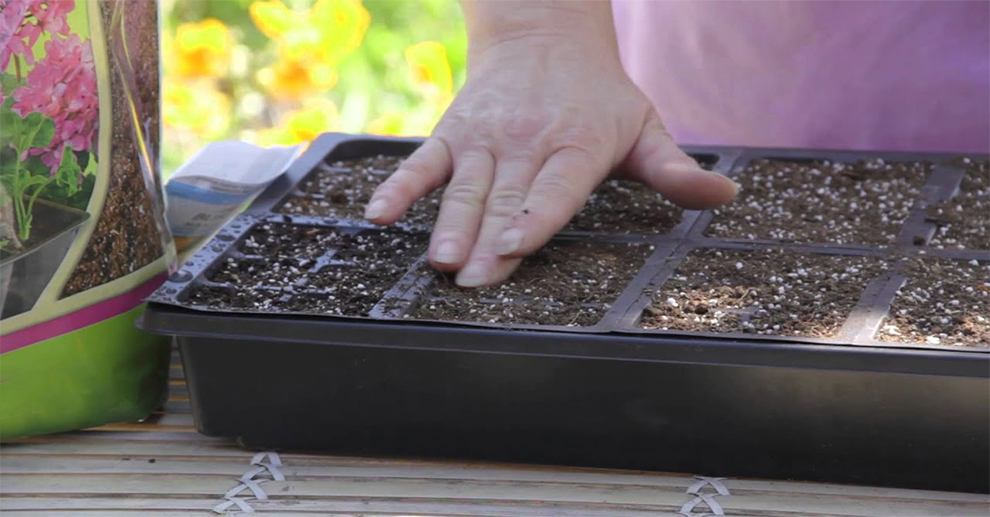
Planting marigolds indoors can be an excellent way to get a head start on the growing season, particularly in areas with a short growing season.
Typically, it is done four to six weeks before the last expected frost date in the area.
To get started:
- Take a small pot or a seed tray with a good-quality seed starting mix.
- Insert one or two seeds in every pot, and cover lightly with soil.
- Keep the soil moist but not waterlogged.
- Move the pots to a warm, sunny spot or under grow lights, ensuring the soil is consistently moist as the seeds germinate and plants grow.
How big should marigold seedlings be before transplanting?
Ideally, marigold seedlings must be at least two to three inches tall and have a few sets of leaves before you can transplant them into a larger pot or garden.
It ensures they have developed a healthy root system and are strong enough to handle the transplanting stress.
Since you know how to start marigold seeds, waiting until the seedlings reach this size also helps ensure they are mature enough to withstand the environment outside.
Marigold Aftercare Post Planting The Seeds
Once you plant the marigold seeds, you must give marigolds proper care to ensure abundant blooms and healthy growth. It includes watering regularly and providing ample sunlight.
Deadheading the spent flowers in mature plants and simultaneously removing the diseased or damaged leaves can help promote new growth and prevent the spread of disease.
Fertilize once a month with a balanced fertilizer to boost growth. With good aftercare, marigolds will continue to bloom and brighten your garden across the growing season.
Is It True That You Can Grow Marigolds From Dried Flowers?
Even though you can obtain seeds from dried flowers, it is not a reliable method of seed collection. The drying process may damage the seeds, or they may not be mature enough to germinate.
Ideally, the flowers must be on the plant until they have developed mature seed heads, which you can harvest and plant to grow new marigolds.
Dried flowers do not have viable seeds and will not germinate. Thus, you must procure the seeds when the marigolds are fully mature and dry them well before storing them for future planting.
